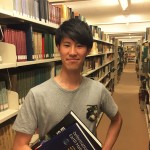 Takuya Kurihana
Takuya Kurihana
University of Tsukuba
Atmospheric Science
Status: B4 Expected Graduation: March 2017
Research Host Lab: Heinkenschloss Lab, Computational & Applied Mathematics, Rice University
![]() Research Project Poster: “Applying Data Assimilation to Parabolic PDES”
Research Project Poster: “Applying Data Assimilation to Parabolic PDES”
Why Nakatani RIES?
I strongly believe that this internship program would give me considerably beneficial opportunity for making my final thesis topic fruitful as well as giving a clear image of my future goal to become a graduate student in the US. Moreover, I’m expecting that I could absorb plenty of cutting edge expertise and knowledge from my mentor, and encounter a happy moment when I explore a small new discovery in this summer. In addition, apart from research activities, I hope to widen my friendships, explore unknown good places in Houston, and deepen my comprehension of US culture here.
One of the significant aspect in international collaboration in science such as this program is that it could have a positive effect on accelerating development of science technology by mingling different ideas of those who have diverse back grounds. I also believe that this program plays a remarkable role in strengthening our friendship as good potential scientists who will gather and work together.
Goals for the Summer
- To make certain progress in understanding data assimilation, my currently research topic
- If possible, to acquire new knowledge or methods to data assimilation from applied mathematical or computing science fields
- To learn the US culture from general to indigenous one
- And to promote Japanese recent culture
- To widen my personal future opportunity in the US
Excerpts from Takuya’s Weekly Reports
- Week 01: Arrival in the U.S.
- Week 02: First Week in My Research Lab at Rice
- Week 03: Interview with a U.S. Researcher
- Week 04: Reflections on English Language & Life in the U.S.
- Week 05: Research in the U.S. vs. Research in Japan
- Week 06: Final Week at Rice & Research Poster Presentation
- Week 07: Visit to Washington, DC & New York City
- Final Report: Reflections on the Nakatani RIES Fellowship
Week 01: Arrival in the U.S.

A bunch of buildings and hundreds of thousands of houses, the image that I saw in a guide book, was nowhere around George Bush International Airport. In contrast, forests spread out every angle. However, once we were in the downtown or around Rice University, there was a mass of medical buildings that I had never seen before. On the bus, each building or houses seemed just as large as Japanese ones. But when I walked on the road, I was noticed how huge they really were.
Considering the first two days in Tokyo, it was enough to be familiar with each other between JP fellows and US ones. At the same time, I was surprised all members have considerably various research interests. Even though some points would hardly be understood for me, their passion toward their research projects in Japan or at their home universities was easily apparent. After arriving at Rice, my resolution to study abroad in U.S or U.K became much stronger because of the panel discussion with Japanese graduate students. Their stories and remarks were really helpful for my up-coming applications.
The weekend NASA tour was awesome! One of my dreams since my childhood came true. Tbe huge rocket was astonishing. And, the party at Prof. Kono was fruitful as well.
Question of the Week
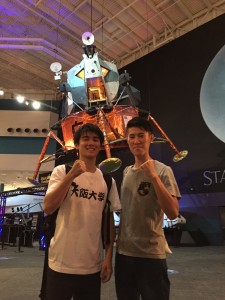
Is the number of Japanese undergrads or grads in Rice larger than other universities in the U.S ?
- Overall, the population of Japanese students at Rice is quite small in comparison with students from India, China, or South Korea. But, because Rice is a small university, it is easy for most Japanese students on campus to meet and get to know each other along with Japanese faculty and staff members too. There are likely more Japanese students at other universities in the U.S., particularly in California and Hawai’i, but the population at Rice is growing and, indeed, many of the Japanese students at Rice are visiting research students like yourself that Prof. Kono and other faculty members are hosting in their labs. We hope the numbers of degree-seeking Japanese students at Rice will continue to grow too. For more on the international student population at Rice see the most recent annual report from the Office of International Students and Scholars (OISS).
How did you prepare for your research project at Rice University before leaving Japan?
I had kept in touch with my adviser before the program. That has made it more smooth to conduct my research so far. He sent me some texts or web pages related to his research projects at Rice, which also assisted with my preparation. In addition, in spite of some JP fellows who are participating research in a little bit different area, my research topic and adviser’s one nearly matched. Thus, there was no hindrance when I started my research here. However, if I learnt new computational language much more, I would not stack with coding models. Fortunately, I am currently working, precisely part time job, in national meteorological institute by taking over my elder colleague in same course. The cutting edge research experience off campus might better me in terms of confidence, which decreases my anxiety about my future academic and professional career.
With regard to an advice for next JP fellows, I would like to say that to specify what you want to do. The clear and concrete reason why, where and what point I would conduct research makes a difference, and renders this program experience more efficient to our future career.
Week 02: First Week in My Research Lab at Rice
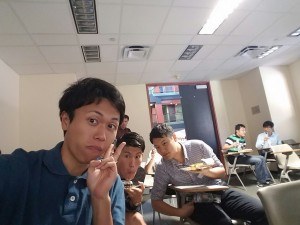
My first week was like a roller coaster. I was faced with a bunch of different cultural situations in terms of group and individual aspects. Even though there were somewhat confusing and fresh moments, I gradually got used to Rice University and Houston.
Lab: In comparison with other Japanese fellows, Computational and Applied Mathematics (CAAM) does not have a formal lab because our experiments are implemented by computer, though my mentor’s office seems to be very sophisticated. Thus, I did not feel any hindrance to my research activity.
Mentors and Professor: My mentor, Caleb, significantly helped me to start up coding a numerical model in the first week. He is such a nice guy that I have felt a great deal of support. Meanwhile my adviser, Prof. Heinkenschloss, is very busy most days, but he also gave me good instructions.
English communication: I have never considered how difficult it is to communicate what I would exactly like to convey in English about academic problems. I sometimes could not choose appropriate expertise quickly, which produced misunderstandings between me and my mentor. Moreover, regardless of nations, there are many discrepancy between each individual, which brought about a minor mismatch of understanding in the way of coding a model, and caused a little bit of frustration with each other. But, other than higher level of academic communication, we are able to get along very nicely. For instance, this week, we often had a lunch with Caleb’s colleagues. Thus, I felt my friendship or connections could expand more widely.
Poster: Dr. Beata Krupa gave us a helpful lecture and a examples of good posters during a seminar this week too. This helped me better envision what
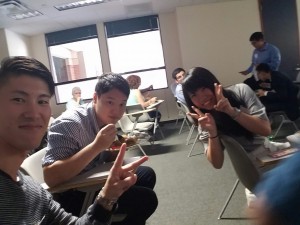
type of poster designs will help the audience better understand my project . Especially, the lecture taught me concise tips for creating a good poster.
Other events: I also joined a Master’s party in Duncan suddenly. I was amazed they opened their mind regardless I am an undergraduate. Helping a math class quiz was good event. My mentor asked me to check his class quizzes including some mistakes. I revised some of them.
Question of the Week
How different is the math education system in Japan and U.S. ?
- By many measures, Japan leads the world in terms of math education and achievement and, unfortunately, the U.S. typically receives lower scores on math achievement by students at all levels when compared to other nations worldwide. One, unfortunate and incorrect assumption, that many U.S. students make is that if they don’t get ‘good grades’ in math as a young student then they aren’t ‘good at math’ and often choose not to pursue the more advanced classes like trigonometry and calculus in high school; which are optional classes typically. This means that fewer U.S. students have the basic math skills necessary to pursue engineering and science degrees. This is slowly changing and more and more students and parents are encouraging students to pursue advanced math in high school so they can go into engineering in college but the U.S. has a long way to go to improve math education; especially at the middle school and high school levels. You may also want to read the article “Differences between the U.S. and Japanese Educational Systems” and ask Prof. Kono this question as his daughters when to school in the U.S. so he may have insights on how the math classes he took in Japan compare to the math classes his daughters too in the U.S.
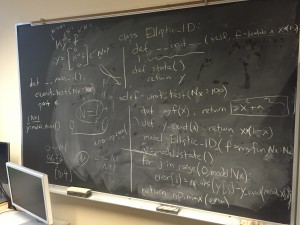
Research Project Update
Overall, this week was a preparation or tune up period for my research. Although I had several troubles when I have coded the models, all of the processes went well.
Research project: We implemented data assimilation methods so called Kalman Filter(KF), EnKF and 4DVar, which seek a better initial condition through the optimization. Finally, I am currently planning that we compare these methods in a numerical model, putting subtle errors followed by Gaussian distribution. In linear system, these outcome will be similar, though in nonlinear system, 4DVar will outperform than EnKF, and KF will be worst.
Research methods and Training: To pursue good results, it is imperative to set up a good model that is satisfied with mathematical or physics theories in even detail. Computing equations and crack them on the paper is slightly different, when it comes to how we calculate the problem. Therefore, we have started from simple models (diffusion and advection advection) to convoluted but more precise ones (shallow water equation). As regard to training, the practice of Python and matlab will help my progress.
Time line: I managed to visualize my 1D time dependent diffusion and advection model in animation, which amazed my mentor. I expect that I can code more huge numerical model (e.g. matrix size 100 by 100), especially shallow water equation model. Hence, we should discuss the concrete plan about the implementation of data assimilation.
Week 03: Interview with a U.S. Researcher

I conducted my interview to my mentor, Caleb who is a graduate student in CAAM. Through this interview, I really understood more about the facts of graduate school in terms of both the positive and negative sides. But, after finishing this interview, my next goal, to be a graduate student in a top school in another countries, became more explicit. In addition, I appended remarks from another future researcher in the Kono lab, who will be going through Ph.D defense.
Caleb has studied mathematics and computer science for 6 years since he graduated with his bachelor’s degree from Virginia Tech, where his major was engineering. I sometimes heard many or a certain part of students changed his course between undergraduate and graduate school. Therefore, it was not so surprising to learn Calbe had changed from engineering to computer science. But, the story that he once hated math blew my mind. How can we imagine that a person who is very enthusiastic for math now, especially algebra, avoided the subject in the past? However, the encounter with a class, specifically a faculty member, decided his current career. He had been fascinated by his attractive class and algebra. Moreover, the experience of researching in senior year also affected his career. A faculty member gave him a task that compares two computer programs, and searches which is better. His start point then was almost as same as I am now. But, he is one of the best programmers who I have ever met. I guess this experience made a difference in his life. To sum up, his background was not so special but very similar with me and one specific event helped him set his career path.
A bunch of students have studied in the Ph.D course. If we also include master’s students, the number must increase further. But how many students could accomplish their desired degree? Data shows, about 60 % in the U.S graduate students managed to get Ph.D degree. Actually, the fact may be more competitive than we expect. Among Caleb’s friends, only 2 out of 6 students were permitted to enroll Ph.D degree after completing their master’s degree. So, I will bear higher risk in case of dropout. Therefore, Caleb had experienced internship in some relevant areas, stuck company or oil company. Apart from just a preparation in case, his interest spread out even in industry. Meanwhile, his interest was eventually in math, partial differential equation, so called PDE.
Listening his career path, I made sure to better understand that I have to have several “cards”, future career paths, apart from researching and studying very, very hard. As a Chinese Ph.D student said, a Ph.D degree does not have significant meaning. What you learnt in your graduate school should be evaluated both on and off campus. I will be happy if what I will study next in school as well as at Tsukuba contributes to developing our world, and exploring new discovery. To accomplish this big dream, I have to broaden my prospective.

Question of the Week
How different does the graduate school style vary in UK and US in terms of funding, evaluation (number of papers or quality of ones) and education?
Research Project Update
With regard to my research progress in this week, I managed to finish coding basic models which will be used from next week. Linear parabolic model with periodic condition and nonlinear shallow water one were successfully constructed, but to visualize 3D animation in later model remains a current program. In case, I am considering a bunch of each step picture could be transformed to movie with using shell script command. However, I will try to make good 3D animation by Python in the weekend.
Fortunately, I have already started the Data assimilation step where I would really examine in this program. Firstly, I re-studied the mechanism of assimilation structure from the beginning by the strict and specific mathematical side of view. In atmospheric science field, some math detail lacks. For example, the proof of cost function, which optimizes an equation to seek better parameters.
We discuss we will use conjugate gradient (CG method) and KF method to compare these RMSE in my models. In my current expertise in meteorological field, there are quite few paper to compare these method since these ones are regarded as higher computational cost performance than others, especially in the huge matrix. Therefore, I am very interesting next week, even if suffering from a plethora of bugs!!!
Week 04: Reflections on English Language & Life in the U.S.
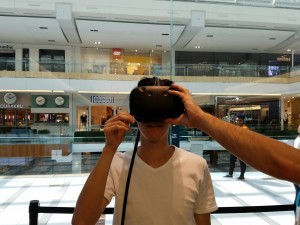
With regard to my English communication experience and learning method, I am making an effort to convey my feelings or ideas directly while making a choice to not use just easy words but a wide range of lexical resources. My final goal is aimed to at being able to manipulate language in English as much as I can in Japanese. Therefore, I do not hesitate trying to speak, even if native speakers ask me to repeat what I have said.
In this report, I will explain my English conversation experiences that I perceived are good examples of special moments in Houston. I also give some examples of techniques I have used to facilitate my English communication.
Case 1 : Research conversation with mentors and adviser.
Fortunately, in the context of communicating with a native English speaker, my mentor was born in the United States and does not have a specific or strong dialect, which has helped my understanding of research topic through this program so far. Even though his English is not similar to a TV newscaster in CNN and he is not English teacher, our conversation has well in almost all senses. In some complex situations, however, we sometimes misunderstand each other’s intention. For example, when it comes to our fundamental perspectives we are totally different, and do not share the same idea. At that time, I thought if I knew more natural or appropriate words, I could have made sense of what I was trying to say. By contrast, the conversation with my adviser Heinkenschloss has been somewhat more difficult compare to communication with Caleb, my mentor. He is German. Thus, it is natural that although he has spent many years in this country, his remarks sometimes get redundant or roundabout, which may sometimes hinder my quick understanding to his advice with adding his Germany dialect. But, in general, we have a one common language, ‘Mathematics’ that connects us strongly. So, when I did not understand his suggestions, I tended to use math expertise or wrote down what I imagined. Overall, to pretend understanding even if do not comprehend is the worst thing in academic communication.
Case 2: Rich conversation with a man
This is a story that I stumbled across outside the hedges of Rice University. When I headed back to campus after enjoying a Starbucks at the café in Rice Village, I found a scene that a man picked up a credit card someone threw or lost. My stereotype reminded me that this he must pick up and use improperly since here is not Japan but US where lost belongings are not returned to their owner. However, he asked me that ‘where is the security building?’ Then, we walked to RUPD office. During our 15 minute walk along the path, we found out that we shared the same hobby, soccer, and experience in Berkeley. This was the exciting moment where I realized I spoke English very naturally. I assumed the kind of experience assists my conversation ability much more.
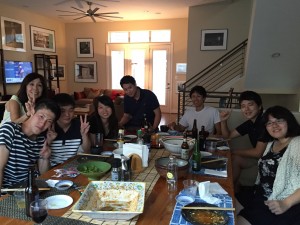
Case 3: How to learn “English conversation”
I have a method to acquire natural English apart from learning slang. One is to imitate what native speaker usually say. There are a plethora of words that people merely use in daily conversation but just in the newspaper. Next, using English as a phrase. That connections of words let me pronounce things a little bit naturally. Finally, do not speak too fast and or with too low of a voice, as this makes difficult people to find out my remarks.
Question of the Week
From the perspective of native speaker, what should students learning English give more precedence to in conversation: a) to speak fluently but abusing grammar, or b) speak slowly but very appropriately in terms of word choice?
- This depends a bit on who you are speaking to. If it is someone who is used to working with non-native English speakers, it may be easier to speak slowly and pause to think of or ‘find’ the correct English word. People who are used to working with non-native English speakers are used to these pauses in conversation and will wait for you to think of what you’d like to say. But remember, that typically in U.S. conversation we don’t like pauses or silence very much. So, if you pause for ‘too long’ the other person you are talking to may interrupt you trying to be helpful and tell you that word they think you mean to say. While this can be helpful, it can also be distracting to your train of thought too. So, if you are speaking with someone who you guess doesn’t work with many non-native English speakers, then it is usually best to speak more quickly and not take long pauses to select the ‘best’ word. If, after you’ve said what you were thinking, they don’t understand you can always follow-up and say, “I’m sorry, what I meant to say was…”
And why many shop clerks do not use ‘how may I help you’? I heard many different phrase in several kinds of shops.
- How may I help you? is just a standard, typical greeting that most people who work in shops are trained to say as soon as a customer comes in. How may I help you? is a way to make sure the customer knows that there is someone there to ask a question of if needed and ensure the shop keeper/clerk is giving good customer service. If you don’t have a question right then, you can always say, “Thank you, I’m just looking for now” and then the clerk will go back to whatever they were working on. That way, you know who to ask for help if you do end up needing it later and this can be helpful as stores in the U.S. are often much bigger than in Japan and clerks do not always wear uniforms or name badges so if you know who the shop keeper/clerk is right when you come in then it will be easier for you to find them later. In a way, it is similar to いらっしゃいませ (irasshaimase) or ‘Welcome’ in Japan which is always said when you walk into a store as well.
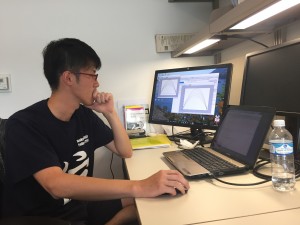
Research Project Update
This week’s progress can be evaluated as good work. We succeeded to introduce Conjugate Gradient method (CG), which is one of the popular optimization method in solving linear matrix problem. With installing a new program that compute assimilation part, we built a flexible program that is able to apply another numerical model as far as these models follow the linear system. We also visualized data assimilation by CG method in 1D time dependent the diffusion and advection model. The graph provided us that early steps and especially initial calculation returned bad “fitting” when we measured these errors. However, as time steps went, the error graph showed more smoothly by assimilating observations and model states with a bunch of matrix information (The size of matrix skyrockets as time step increases). On top of that, the diffusion coefficient in this model PDE reflects the pattern of error. The stronger the diffusion, the bigger the error of left side since wind in model blows from right side. I and Caleb was so excited when we figured out the truth of this error trend.
The next step focuses on data assimilation in 2D model and non-linear case. I would like to get a beautiful graphs that show the fitting process and truth graphs, comparing these time steps’ trend. I am very happy to explore my field with a small but definitely forwarding step.
This is just a standard/expected greeting when you go into a shop. Store clerks and attendants in the U.S. are trained to say this and to offer help to customers first as this is seen as giving good customer service. In Japan, shopkeepers say which meansいらっしゃいませ (irasshaimase) which means welcome but also implies that the shop keeper knows you are there and if you have questions you can come ask him/her if you neeed. How may I help you? is similar – it is more of a greeting than an actual question. If you don’t need help right when you come in, you can just say, “Thank you, I’m just looking for now”. Then if/when you need help you can ask the shop keeper again since you know who they are now and can find them. Knowing who the shopkeeper is can also be helpful since stores in the U.S. tend to be bigger than in Japan and they may not always wear a uniform/name badge so you can’t always easily tell who the shop keeper is.
Week 05: Research in the U.S. vs. Research in Japan
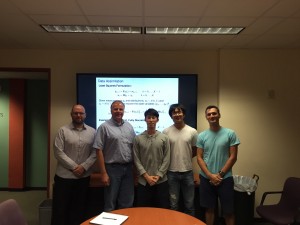
The past about 4 weeks and this weekend has an important meaning, when it comes to thinking about the difference in styles between Japan and the U.S, and what research life in the U.S research is like. I spent intense days in the research lab with Prof. Heinkenschloss. On top of that, I made a short visit to the lab of Prof. Fuqing lab at Penn State in this weekend seems to be good opportunity to compare the difference between the two countries.
First and foremost, in both countries students’ perspective to a graduate school life contains a subtle difference. As is widely known, graduate students in the States get a salary, which explicitly means that they are “hired” by their boss or university, whereas Japanese graduate students pay their tuition. Therefore, I have felt the sense of responsibility to their research topics is greater from U.S graduate students than my senior colleagues in Japan. I do not imply Japanese graduate student are lazy. They study as much as they can as well. But, considering my mentor’s work to my current research project at Rice, he helped me even in weekend since this is his ‘job’. With regard to motivation, I am concerned that the sense of job toward their daily research deprives them of the natural enthusiasm, and can imagine those who hate the project may still feel forced into this high-pressure environment. In addition, I also perceived the collaboration with industry accounts for a certain extent in U.S graduate students’ work. In Japan, my department’s faculty also work with companies, but graduate students, especially master’s students, are not expected to focus on or are not involved in these projects. I think both styles about whether students are almost employed or keep being ‘student’ has pros and cons as I discussed above. The speed of outcome, however, could vary since U.S laboratories are more dedicate to their research outcomes through collaboration with each other.
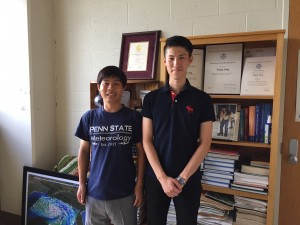
Next, I would like to explain my insight toward the ‘collaboration’ above, using three examples in Rice, Penn state and my lab. Rice and Penn State labs deal with numerical modeling, though the former one sometimes cooperates with an oil company and the later one creates relationship with national research institutes. Therefore, students in these labs have opportunities to experience the short research internship in a partner company or national institute. By contrast, while my lab somehow collaborates with other institutes, the strength of ‘partnership’ does not seem to be stronger than the Rice and Penn State cases. Curiously, both Dr. Fuqing in Penn State and Masashi Minamide, a graduate student at Penn State, pointed out that researchers in the U.S can much more easily get in touch with other groups and tackle a similar topic, which accelerates the exploration of cutting edge fields. I assume this environment enables U.S researchers to generate great research results. Masashi’s analysis was so fresh in that the characteristic of language may attribute to this situation. In English, the way of expression tends to be more directly like ‘Hi!’, or ‘I want to ….’ In comparison, Japanese requires listeners to infer what speakers are truly asking for.
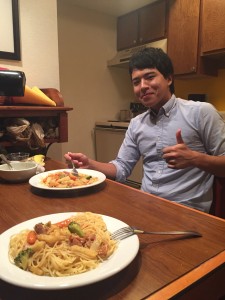
Overall, at first glance, each lab member’s responsibilities are evaluated more in the States, which is the truth. Finally, each member’s effort, however, are integrated to yield a new discovery or improvement. As they are working in same filed, this point makes a difference between the two countries.
Question of the Week
In general, do professors appreciate their students experiencing internship in other groups or industry?
- Most professors see that the future successful careers of their graduate students reflects positively on their work/research lab as well. So they often connect their graduate students with opportunities to do research in other settings, such as industry, national labs, or abroad, so that students can expand their skills and build their professional networks. In the U.S., students typically pursue these opportunities during the summer months (June – August) when they typically do not have any classes. However, the timing of when you do an internship as a graduate needs to be carefully discussed with your research advisor. If it is a very important/busy times for you to get good research results and your internship would detract from your progress towards your master’s or Ph.D. degree then your advisor might not be so supportive and would ask you to reschedule. It is always a good idea to talk with your advisors about internships or other opportunities at the start of your program so she/he knows that you are interested and then they can let you know of a good opportunity when they hear of one. This is also something you can ask when you are considering which graduate school to attend or what lab group to join: “Do students in your program/lab group have opportunities to participate in internships or other research at different institutions?” Depending on how the professor answers this question you will know if they are supportive of these opportunities or not.
Research Project Update
We are in the final stage where we fixed some minor points in program and generates outcomes as well as making draft of poster and technical report for my lab. In addition, our data assimilation was applied toward 1D and 2D linear models so far, though we challenged non linear assumption model case that my mentor and adviser have coded. So, we divided our project in 3 parts; I have implemented a data assimilation method, which is fundamentally similar to the 3DVar and Kalman filter. My mentor expands models form linear to non linear, and adviser is coding the solution part, which optimizes the objective function, going through several methods. As regards the basic assumption of model system, we have to introduce a new solving method. We used conjugate gradient method that can be conducive to sparse matrix, following a linear model. But, in non linear case, this method does not work since matrix computation skyrockets through solution calculation. Hence, Gauss Newton method or BFGS method should be introduced into our numerical models because these methods do not directly compute big matrix.
Even though we may not compare multiple assimilation methods in this project that I firstly imagined my goal in this summer. We gave up using a shallow water model, which visualize more realistic atmospheric phenomenon. However, applying data assimilation toward simple models surely deepens my understanding the fundamental theory about this topic. Next week is final week. I would challenge as possible as I can.
Week 06: Final Week at Rice & Research Poster Presentation
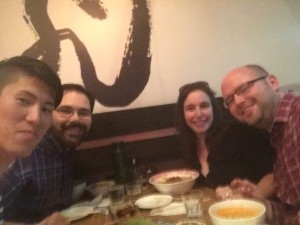
Even though I had visited U.S as a student before in California, this second experience in Houston influenced me a lot. As I mentioned above, this is not first study abroad despite this being my first research experience in the U.S, so I rather perceived the difference between states in this country, which is perhaps the point where my perspective has changed. In other words, this second visit made my insights to America more specific. For example, California, especially San Francisco and Houston are totally different in terms of people’s characteristics and the structure of society. Here, Houston tends to be more distinct open mind to others, and European people account for higher class of social hierarchy, while Hispanic and African American participate in jobs requiring the heavy physical tasks. By contrast, in San Francisco, there was a more miscellaneous social environment.
I propose my country should learn from one of the advantages of the U.S that many citizens do not hesitate to talk with others regardless of their relationships. Between students and faculty members, elderly people and younger ones, and different races, they do not create barriers to others. If Japanese society would struggle to decrease their barrier and change from being shy to more open minded, I believe we would be sure to create more great work. In my idea, this is oen reason why U.S has produced outstanding outcomes in academics, sports and industry. Other than the fact a bunch of distinguished geniuses gather from all corners of world, there is no hindrance to start talking or anything of new.
I am not sure about whether I will come back to U.S as a graduate student or not since I am not only applying to institutions in the U.S. However, the dense 5 week research experience definitely impacted my life beneficially. In my case, although I brought my research topic at Rice rose out of my undergraduate dissertation research at the University of Tskukuba, I was in mathematics research group where more strict and accurate mathematic approaches were required. This enabled me to get the most fundamental part of data assimilation from the mathematics aspect. In addition, the manipulation of new computer language or math formulations were challenging tasks. Finally, I was able to accomplish these tasks. My heart is full of the sense of achievement. Borrowing the famous words of J.F. Kennedy, “This is one small step for a professional, one giant leap for me”.
I became more easygoing than in Japan. Sometimes, there were situations that I should understand the higher level of expertise by English at one time, and also explain explicitly. This would be as challenging even in Japanese. These situations were really annoying. Moreover, I felt how different the academic English and daily conversation is, complex and peculiar word choices made me very confused and irritated. Therefore, I tried not to pay attention too much toward what I did not comprehend, and became just more easygoing.
The final week flew by just like a jet plane! In my final weekend in Houston, my mentor coded the 2D model, so I replaced almost all experiment’s graphs in poster! After implementing my experiment to 1D model that I did on airplane on the way of Penn State in weekend, rushing to temporally create a provisional poster on Monday. And then, I re-wrote my poster from 1D model to 2D model again just in a couple of hours on Tuesday. Finally, on Wednesday, I, technically, I and mentor managed to finish this good work. So, the farewell party with my mentor was awesome since we are fellow researcher who went through same severe situation!!!!!
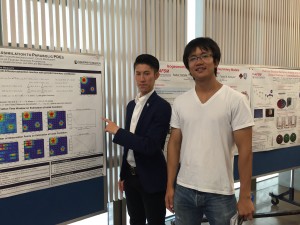
Poster session is very different in comparison with a typical presentation. The speaker should respond lots of questions throughout the talk, and changed the talking points completely depending on the audience. That was tough job, but more experience of explanation improved my poster presentation level, and this will benefit me in my future sessions such as presenting at a conference or dissertation seminar in my department.
I will remember numerous people: my mentor, his friends, my adviser, colleagues in my office, Kono-sensei, Aki-san, Shimizu-sensei and so on. All of the moments in Houston were special. I remembered the relationship with my mentor seemed to be the worst in the first 3 days. We had a big discrepancy toward the research. It was natural that I am just senior undergraduate student and he almost will be a post-doc next year. But, as we gradually kept talking, more and more our bond became closer. That was a nice human experience. I really appreciated his kindness and great help. Even if the next time we meet in my life will come in the far future, I cannot erase our 5 weeks. Thanks, Caleb.
Final Research Project Update
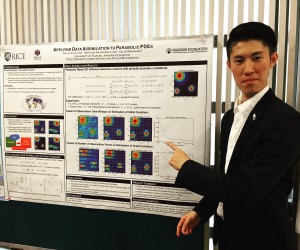
Research Project Poster: “Applying Data Assimilation to Parabolic PDES”
Research Host Lab: Heinkenschloss Lab, Computational & Applied Mathematics, Rice University
Graduate Student Mentor: Caleb Magruder
Introduction: Effective weather prediction requires information of atmospheric conditions e.g. wind, humidity, temperature, etc. at an initial forecasting time. The goal of data assimilation is to combine mathematical models and a limited number of observations to estimate atmospheric conditions at an initial forecasting time and predict unknown atmospheric conditions. These much more precise information of initial condition enables much longer robust weather predictions.
Approach: We run our simulations on a simplified physical model, the two-dimensional diffusion-advection partial differential equation with periodic boundary conditions. After setting this simple numerical model, the data assimilation methods can be implemented next. The data assimilation problem can be formulated as a least squares problem, minimizing misfit in observation measurements and model updates followed by a linear system.
Results: Results are run on a square domain, [0, 1] × [0, 1]with periodic boundary conditions, dominant advection coefficient rather than diffusion, and changing final simulation time window T from K = 0.1 ~ 0.5. The model was discretized with implicit Euler in time and finite differences in space with a grid size of [32 × 32] and observation numbers vary between 36, 81 and 100. With regard to increase of time window, which means how long I take the length of time for getting observation information, and the number of observation points, the analysis of initial condition retrieved and got close to truth condition.
Discussion: In this study, adding measurement locations was more beneficial than widening time window. This is because observation errors are relatively lower than model simulation results. Thus, the number of current information source has a more critical impact on the fitting process. Moreover, the 100 points experiment verified the analysis completely recovered the almost accurate real condition. It seemed to be very dense distribution rather than other lower observation points study, while in comparison with all amount of grid number, the 100 points only accounted for about 10 per cent area in whole grid area. Overall, data assimilation can work well in spite of introducing few information.
Future Research: In this study, I verified how data assimilation was influenced by time window or observation numbers in the linear system, whereas the outcome of the non-linear system has not conducted. Therefore, it is worthy that next step deals with the non-linear system, more complicated and challenging condition since the real atmospheric system is non-linear system.
Conclusion: To sum up, I tackled these topics below in the 5 weeks research internship,
- Python: Numerical library (NumPy+SciPy) and object oriented programming
- Least squares formulation (Conjugate Gradient and Gauss-Newton)
- Numerical methods to solve 1D and 2D parabolic PDEs
- Adjoint-based data assimilation for linear PDE model
Especially, the fourth item needs tricky programming technique even in Python that has fruitful library resources. Hence, I learned not only expertise of data assimilation but also enhanced fundamental skills of the data scientist.
Week 07: Visit to Washington, DC & New York City

After completing research activity in at Rice University, we explored several research environments and the connection between the science & technology and the society including the aspect of politics or public interest. I know many officers and researchers have tackled how science or engineering technology can assist our life as well as convincing of a lot of citizens and politicians who are not familiar with these research fields. Free time in final week also had significant meaning as it helped us comprehend U.S culture. And finally, I am going to describe how my perspective has altered after coming back to Japan below.
First and foremost, I had some precious time to learn about the current situation in White House Office of Science & Technology Policy (OSTP) from Kei Koizumi and the activities of the United Nations from Alexander Roehrl this week. The science policy decision system in America seems to be very changeable by President’s ideas, so Kei and his colleges at OSTP have to make a plethora of potential plans. Science and technology contains a wide range of areas from physics to medical field, while only more or less 15 specialists are charge of supporting the next few years about science policy direction. Therefore, I felt that each expert should owe more responsibility and be equipped with plenty of knowledge toward these topics. The UN talk also showed difficulties. The activity facilitates information about practical science to disseminate to citizens and communities in a small area, though when it comes to world problems such as global warming and water resource, they are required to involve many countries’ UN delegates for integrating each country’s vector of scientific countermeasure toward these issues. The relationships between NGOs should be fortified to have greater influence. To sum up, a lot of people strive to visualize a better society by approaching challenges through the science and engineering side, whereas limitations like the number of officers in White House and duplication of NGO activity by similar groups have to be reconsidered.
The visit to Prof. Thomas Searles at Howard University and Prof. Uemura and Prof. Pierre Gentine at Columbia University had explicit benefits for my career. Dr. Searles was the youngest faculty member I’ve met through my lab visits, so I could ask him things very directly. And at Columbia, Prof. Uemura was very helpful planning for our visit. Thanks to his effort, I really enjoyed what Columbia University contributes to developing science or, more generally, top research universities have done. In my short interview with Dr, Pierre, who may be my prospective adviser, there might be a good position as a graduate student there despite the fact that he would rather use data assimilation as one method for detecting vegetation distribution of the earth while I would rather improve the theory.
Here, I am writing what kind of experience I went through in D.C and New York during my free time. At first, the exploration of diversity in “city”! Both cities are big city, especially NY is as large as Tokyo. But there are different histories in comparison with Tokyo. New and well planned, these younger cities have grid shape of framework in town, which made me easily understand to hang out everywhere I want to go. I love D.C in that urban areas and parks are harmonized well. At the same time, I also prefer NYC where there was a lot of culture, skyscrapers, and good restaurants were nearby. Times Square showed more diversity and chaos than Tokyo. We found a tasty Chinese food in China Town. Irish restaurants were good as well. Finally, at least Manhattan was relatively safe if we pay attention to minor crimes. I fully enjoyed walking around downtown and perceived the peculiar atmosphere of these cities. To choose one best place seems difficult since I met numerous nice scenery.

With regard being back in Japan, the relived emotion came first. The original atmosphere, peaceful but humid, made me realize I was back in my country. Moreover, I was able to ponder what I gained from this program in a more relaxed situation. The growth of my research skills would be the biggest factor, though friendship, in other ward, “connection” surely was built through these several weeks. Prof. Kono’s anecdote, “why I am here (U.S) ” really moved my passion. Dr. Heinkenschloss supported my research with great ardor as well as my mentor Caleb. Sarah, Aki-san and the Nakatani Foundation also helped me. Without their assistance, we cannot accomplish such a distinguished and fruitful 7 weeks. And, I made many life-long friends who are not only Japanese and American fellows but also my mentor, his colleagues and those who I met in the U.S. I owe many thanks towards all member of this program and this comes from the bottom of my heart. I am so happy I had this experience. Subtle changes of my perspective to US, diversity and contradiction, are also new for me. America is composed of each individual’s characteristic. I learned that to respect others and to be sincere are the most important things to be evaluated by others, even in the U.S.
Finally, again, I very much appreciate the opportunity to participate in this 7 wees research internship.
Final Report: Reflections on the Nakatani RIES Fellowship
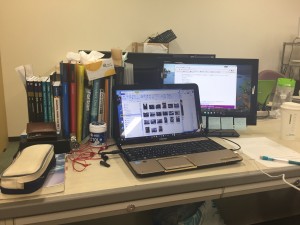
Unfortunately, I have not been able to go back my hometown yet, so I did not tell this long summer memories for them. But, they were relieved that I safely reached my apartment. My professor is now in charge of the university branch which promotes student’s studying abroad as well as worries about the current status of the introverted nature of younger students. Therefore, he evaluated my summer research abroad experience. As I wrote several times in this weekly report, I am currently working at Meteorological Research Institute (MRI) as an assistant researcher. My employer, technically my instructor, also celebrated my safety back like relatives. He was concerned about me since I re-started my work next day I arrived at Tsukuba. But, we do not have any break time. In the last of the month, the biggest meteorological seminar will be hold at Nagoya. In order to prepare my instructor’s session, my hard work continues.
When speaking to a student at your university, what would you say were the most important things you learned from the Nakatani RIES Fellowship program?
I had a chance to meet my teammates and went to a bar few days ago. All of them have a definite next career plan from next April. Yes, except me! They know of my goal, applying and entering a graduate school overseas, and what I did this year: studying and researching with great enthusiasm to pursue my goal. Thus, they were not so surprised about this summer’s experience but were impressed when I talked with them about my memories in New York City.
As soon as I returned to Tsukuba, the opportunity to have English conversations and lessons with my friend, who will work in Ministry of Foreign affairs, re-lunched as well. He admitted my English skills, particularly my spoken English, became more fluent and smooth. He and I now striving to improve our English capabilitites so we can become more sophisticated English speakers.
Are there things you will do differently as a result of your participation in the Nakatani RIES Fellowship program?
There are two completely different points after this summer. First and foremost, my life style. My previous daily routine can be expressed as a “marathon”. I did not take sufficient time sleep, even now I may not sleep as long as other ordinary undergraduates, and I would keep studying or programming. But, what I learned during my time at Rice University was that it is not only important to develop research skills but also important to learn how to manage my time efficiently. I totally reconsidered my style and shifted to becomes a morning person from being a night owl. So far, the results of this switch are very good. Enough rest brings me more power to work energetically. My efficiency has dramatically increased. Secondly, my vision. Before, my future career was blurry but now it has become more clear through meeting many different people.
What advice do you have for future participant in the Nakatani RIES Fellowship for Japanese students?
As an alumnus, I would like to offer this reminder: By citing the famous words by Dr. Clark, “be ambitious”. In order to render this program more fruitful for you, I greatly recommend that you decide firmly what you want to do and experience throughout this program and pursue that with strong motivation. These goals may not be restricted to only research topics. English skill is nice, making many friends sounds great, and enjoying plenty of American culture is awesome. At first glance, 7 weeks may be long. Actually, the time passed as fast as a jet plane. Therefore, set your goals very concretely and dedicate your time for your goal.
